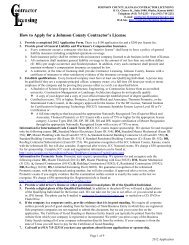Johnson County Contractor Licensing
Johnson County Contractor Licensing
Johnson County Contractor Licensing
Create successful ePaper yourself
Turn your PDF publications into a flip-book with our unique Google optimized e-Paper software.
Diagnosis of flue gases residential, commercial<br />
Testing procedures and interpretation<br />
Draft and why it is important<br />
Flue gas emissions and compliance standards<br />
The equipment, the building, the technician and how to avoid conflicts<br />
Building influences on equipment performance<br />
Combustion & heat exchanger trouble shooting<br />
Ensuring safe, efficient, reliable operation and full operation verifications<br />
Working with Authorities Having Jurisdiction<br />
Proving what you have done and documentation<br />
We will discuss carbon monoxide alarms: how they impact your business and how to deal with situations not<br />
related to your equipment. During the course we will examine how best to use combustion analysis and how<br />
to use it to improve your business, as well as how to reduce call-backs. This program will be of greatest interest<br />
to Class DM Mechanical and DP Plumbing <strong>Contractor</strong>s, but will interest anyone working with or<br />
around fuel burning equipment.<br />
Instructor: Bob Dwyer<br />
15-7A Motors, Generators, and Transformers<br />
8:00 AM to 12:00 PM 4 Hours A, B, C, DE Specialty Code Credit<br />
This course will provide the attendee with an overview of NEC® Articles 430, 445, and 450. We will consider<br />
the code requirements for the general application of motors, generators, transformers, and transformer<br />
vaults. Protection requirements for motor circuit components Will be discussed as will the calculations encountered<br />
in all three articles. We will discuss calculation procedures necessary for both commercial and<br />
industrial installations. This course is designed for Class DE Electrical <strong>Contractor</strong>s, as well as master and<br />
journeyman electricians, design professionals, building inspectors and plan analysts.<br />
Instructor: Mike Panethiere<br />
15-7B Grounding and Bonding in the 2011 NEC<br />
1:00 PM to 5:00 PM 4 Hours A, B, C, DE, DS Specialty Code Credit<br />
This half-day overview of grounding and bonding reviews portions of the 2011 National Electric Code requirements.<br />
The accompanying coursework, Soares Book on Grounding and Bonding, 11th Edition, provides<br />
attendees with intensive instruction on the mystery surrounding seldom discussed grounding and<br />
bonding topics. Specific grounding and bonding issues impacting our state and region. This course is especially<br />
well suited for Class DE and DS contractors, master and journey level tradesmen, designers, and<br />
code officials.<br />
Instructor: Mike Panethiere<br />
Thursday, February 16, 2012<br />
16-1A Fundamentals of Photovoltaic Technology<br />
8:00 AM to 12:00 PM 4 Hours A, B, C, DE Specialty Code Credit<br />
In this course students will learn how solar cells convert light into electricity and how they are manufactured,<br />
what technologies are currently on the market, and how to evaluate the potential of solar cell technologies.<br />
We examine the problems and the potential of current and emerging photovoltaic technologies. We will discuss<br />
how a solar cell converts solar energy to electricity and will consider what limits solar cell performance<br />
and the relationship between performance and cost during this introductory class.<br />
Instructor: Dan Chiras<br />
16-1B Photovoltaic Technology and the Codes<br />
1:00 PM to 5:00 PM 4 Hours A, B, C, DE Specialty Code Credit<br />
While photovoltaic (PV) systems have been addressed through Article 680 of the National Electric Code for<br />
many years, there are a number of challenges with the installation of PV systems which are code compliant.<br />
Lack of experience installing the direct-current portions and the distribution of non-listed equipment, along<br />
undersized conductors or overcurrent devices, can be significant contributors to the installation of systems<br />
6



